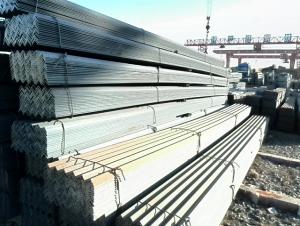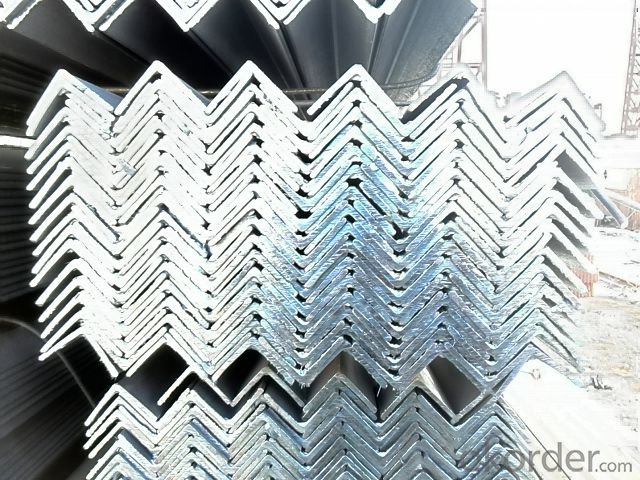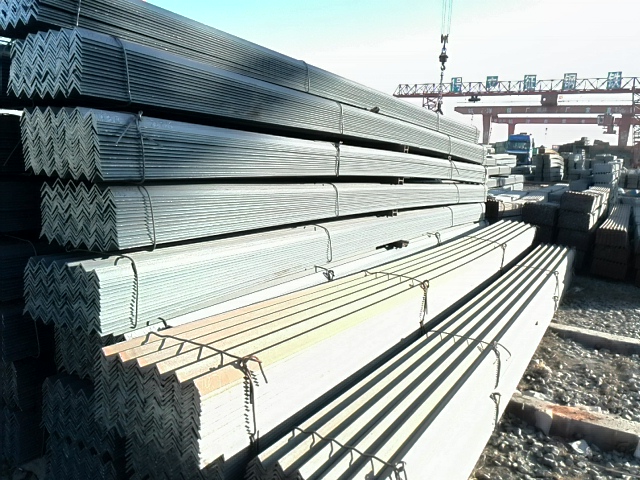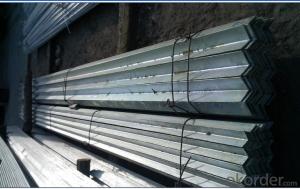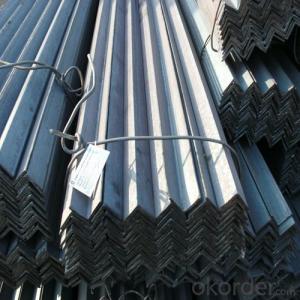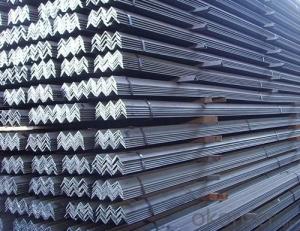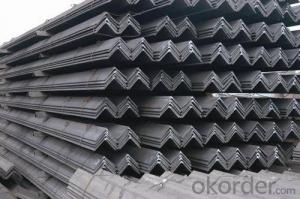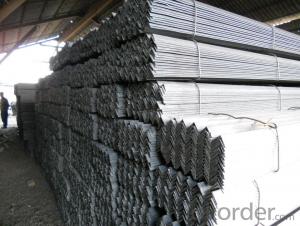Equal Angles Steel with Grade GB-Q235 for Structures
- Loading Port:
- Tianjin
- Payment Terms:
- TT or LC
- Min Order Qty:
- 25 m.t.
- Supply Capability:
- 10000 m.t./month
OKorder Service Pledge
OKorder Financial Service
You Might Also Like
Product Description:
OKorder is offering high quality Hot Rolled Equal Angle Steel at great prices with worldwide shipping. Our supplier is a world-class manufacturer of steel, with our products utilized the world over. OKorder annually supplies products to European, North American and Asian markets. We provide quotations within 24 hours of receiving an inquiry and guarantee competitive prices.
Product Applications:
Hot Rolled Equal Angle Steels are ideal for structural applications and are widely used in the construction of buildings and bridges, and the manufacturing, petrochemical, and transportation industries.
Product Advantages:
OKorder's Hot Rolled Equal Angle Steels are durable, strong, and resist corrosion.
Main Product Features:
· Premium quality
· Prompt delivery & seaworthy packing (30 days after receiving deposit)
· Corrosion resistance
· Can be recycled and reused
· Mill test certification
· Professional Service
· Competitive pricing
Product Specifications:
Manufacture: Hot rolled
Grade: Q195 – 235
Certificates: ISO, SGS, BV, CIQ
Length: 6m – 12m, as per customer request
Packaging: Export packing, nude packing, bundled
EQUAL ANGLES SIZES |
| ||
a(mm) | a1(mm) | thickness(mm) | length |
25 | 25 | 2.5---3.0 | 6M/12M |
30 | 30 | 2.5---4.0 | 6M/12M |
38 | 38 | 2.5 | 6M/12M |
38 | 38 | 3.0---5.0 | 6M/12M |
40 | 40 | 3.0---6.0 | 6M/12M |
50 | 50 | 3 | 6M/12M |
50 | 50 | 3.7---6.0 | 6M/9M/12M |
60 | 60 | 5.0---6.0 | 6M/9M/12M |
63 | 63 | 6.0---8.0 | 6M/9M/12M |
65 | 65 | 5.0---8.0 | 6M/9M/12M |
70 | 70 | 6.0---7.0 | 6M/9M/12M |
75 | 75 | 5.0---10.0 | 6M/9M/12M |
80 | 80 | 6.0---10.0 | 6M/9M/12M |
90 | 90 | 6.0---10.0 | 6M/9M/12M |
100 | 100 | 6.0---12.0 | 6M/9M/12M |
120 | 120 | 8.0-12.0 | 6M/9M/12M |
125 | 125 | 8.0---12.0 | 6M/9M/12M |
130 | 130 | 9.0-12.0 | 6M/9M/12M |
140 | 140 | 10.0-16.0 | 6M/9M/12M |
150 | 150 | 10---15 | 6M/9M/12M |
160 | 160 | 10---16 | 6M/9M/12M |
180 | 180 | 12---18 | 6M/9M/12M |
200 | 200 | 14---20 | 6M/9M/12M |
FAQ:
Q1: Why buy Materials & Equipment from OKorder.com?
A1: All products offered byOKorder.com are carefully selected from China's most reliable manufacturing enterprises. Through its ISO certifications, OKorder.com adheres to the highest standards and a commitment to supply chain safety and customer satisfaction.
Q2: What makes stainless steel stainless?
A2: Stainless steel must contain at least 10.5 % chromium. It is this element that reacts with the oxygen in the air to form a complex chrome-oxide surface layer that is invisible but strong enough to prevent further oxygen from "staining" (rusting) the surface. Higher levels of chromium and the addition of other alloying elements such as nickel and molybdenum enhance this surface layer and improve the corrosion resistance of the stainless material.
Q3: Can stainless steel rust?
A3: Stainless does not "rust" as you think of regular steel rusting with a red oxide on the surface that flakes off. If you see red rust it is probably due to some iron particles that have contaminated the surface of the stainless steel and it is these iron particles that are rusting. Look at the source of the rusting and see if you can remove it from the surface.
Images:
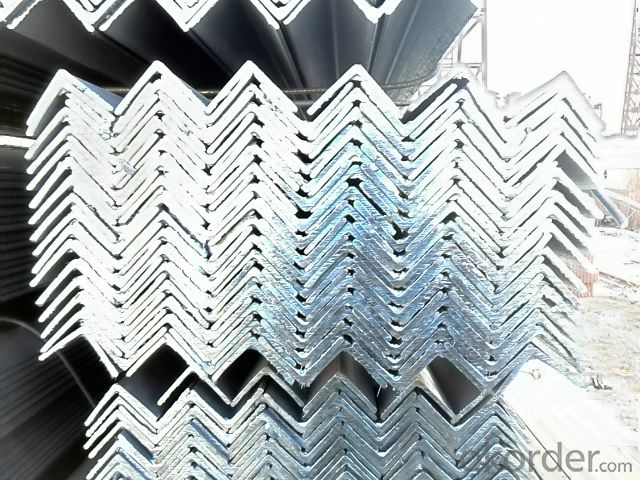
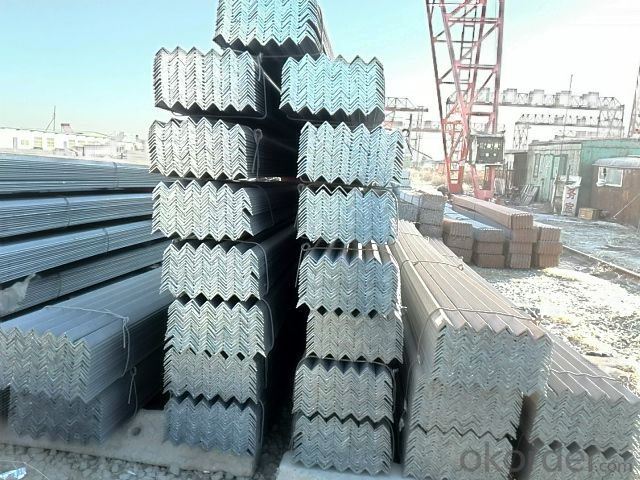
- Q: How do you prevent steel angles from warping?
- One way to prevent steel angles from warping is by properly controlling the cooling process after the steel has been formed. This can be achieved by using quenching or controlled cooling techniques. Additionally, ensuring that the steel angles are properly supported during the cooling process and avoiding sudden temperature changes can also help prevent warping.
- Q: How do you protect steel angles during transportation?
- To protect steel angles during transportation, several measures can be taken to ensure their safety and prevent damage. Firstly, it is important to securely package the steel angles in a way that minimizes movement and prevents any kind of direct contact with other objects that may cause scratches or dents. This can be achieved by using suitable packaging materials such as protective films, foam padding, or cardboard sheets. Additionally, the angles should be stacked and arranged properly in the transportation vehicle to avoid shifting during transit. They should be placed on a stable and level surface, and if multiple layers are required, interlayer materials like wooden boards can be used to provide stability and distribute the weight evenly. It is also crucial to consider the climate conditions during transportation. If the steel angles are being transported in an open vehicle, they should be adequately covered with waterproof tarpaulins to protect against rain, snow, or other weather elements. If the angles are being transported in a closed vehicle, it is still important to ensure proper ventilation to prevent condensation and rust formation. Lastly, careful handling and loading/unloading procedures are essential to protect the steel angles from impacts and mishaps. The use of appropriate lifting and handling equipment, such as cranes or forklifts, should be employed to minimize any potential damage during these processes. By following these protective measures, the steel angles can be safeguarded during transportation, ensuring they arrive at their destination in optimal condition, ready for use or further processing.
- Q: How do steel angles perform in high-vibration environments?
- Due to their exceptional structural strength and stability, steel angles are a perfect match for high-vibration environments. Steel's inherent properties, such as its impressive tensile strength and rigidity, enable steel angles to endure dynamic loads and vibrations without compromising their structural integrity. In machinery, construction, and transportation, where vibrations are prevalent, steel angles are widely used. The performance of steel angles in high-vibration environments is also attributed to their L-shaped cross-section design. This configuration provides additional support and resistance against bending and torsional forces, making steel angles more resistant to vibrations compared to other materials. This design feature effectively minimizes the risk of deformation or fatigue that could arise from constant vibrational stress. Furthermore, steel angles can be further reinforced to withstand high-vibration environments through surface treatments and coatings. Techniques such as galvanization or painting can be employed to apply a protective layer that enhances corrosion resistance and prevents the degradation of the steel's mechanical properties. This added protection ensures the long-lasting durability of steel angles in challenging environments. To summarize, steel angles are the perfect choice for high-vibration environments due to their robust nature, L-shaped design, and potential for surface treatments. Their ability to withstand dynamic loads, resist bending and torsional forces, and maintain structural integrity make them dependable and efficient components in various industries where vibration is a concern.
- Q: What are the different surface finishes available for steel angles?
- Some of the different surface finishes available for steel angles include hot-dip galvanized, painted, powder-coated, and untreated/raw.
- Q: Can steel angles be welded?
- Yes, steel angles can be welded. Welding is a commonly used method to join steel angles together. It involves heating the steel angles to a high temperature and then applying a filler material, usually in the form of a welding rod or wire, to create a strong bond between the angles. Welding provides a secure and durable connection between steel angles, making it suitable for various applications in construction, manufacturing, and other industries.
- Q: Can steel angles be used in temporary or modular structures?
- Indeed, temporary or modular structures can make use of steel angles. These angles are frequently employed in construction owing to their strength, adaptability, and affordability. Their primary function is to offer structural support and stability in a wide array of applications, including temporary or modular structures. The versatility of steel angles lies in their ease of cutting, welding, and bolting, allowing for convenient assembly and disassembly of such structures. Furthermore, steel angles possess the ability to endure substantial loads and provide exceptional resistance against bending and twisting forces, guaranteeing the stability and safety of the structure.
- Q: What are the advantages of using steel angles in construction?
- There are several advantages of using steel angles in construction: 1. Strength and durability: Steel angles are known for their high tensile strength, making them an ideal choice for construction projects that require structural support. They can withstand heavy loads and provide stability, ensuring the longevity and safety of the structure. 2. Versatility: Steel angles come in various sizes and dimensions, allowing for flexibility in design and construction. They can be easily cut, welded, and shaped to fit specific requirements, making them suitable for a wide range of applications. 3. Cost-effective: Steel angles are relatively inexpensive compared to other building materials, such as concrete or wood. They offer a cost-effective solution without compromising on quality or structural integrity. 4. Fire resistance: Steel angles have excellent fire resistance properties, making them a safer choice for construction. In the event of a fire, steel angles will not burn, warp, or emit toxic fumes, reducing the risk of structural collapse and providing more time for evacuation. 5. Sustainable and eco-friendly: Steel is one of the most recycled materials in the world. Using steel angles in construction promotes sustainability and reduces the demand for new steel production. Additionally, steel is 100% recyclable, ensuring minimal environmental impact. 6. Easy installation: Steel angles are lightweight and easily transported to the construction site, making them convenient for installation. Their ease of handling and quick assembly can help reduce construction time and labor costs. 7. Resistance to corrosion: Steel angles can be treated with protective coatings, such as galvanization, to enhance their resistance to corrosion. This ensures that the structure remains durable and maintains its structural integrity even in harsh environmental conditions. Overall, the advantages of using steel angles in construction include their strength, versatility, cost-effectiveness, fire resistance, sustainability, easy installation, and resistance to corrosion. These qualities make steel angles a popular choice for various construction projects, ranging from residential buildings to large industrial structures.
- Q: What are the design standards for steel angles?
- The design standards for steel angles depend on the specific application and industry requirements. However, there are some general design standards that are commonly followed in the construction and engineering fields. One important aspect is the dimensional and mechanical properties of the steel angles. These properties include the angle's size, thickness, length, and weight. The dimensions are typically specified in millimeters or inches, and the mechanical properties determine the angle's strength and load-bearing capacity. In terms of shape, steel angles are typically L-shaped with equal or unequal legs. The equal-legged angles have two legs of the same length, while unequal-legged angles have two legs of different lengths. The angle's shape and geometry play a crucial role in determining its structural integrity and stability. Another important consideration is the material specification for the steel angles. The material used for fabrication should meet certain standards, such as the American Society for Testing and Materials (ASTM) specifications, to ensure the required strength, ductility, and toughness. Commonly used materials for steel angles include carbon steel, stainless steel, and alloy steel. The design standards for steel angles also include guidelines for connection details. These details specify the method of connecting the angles to other structural members, such as beams, columns, or plates. The connection details ensure proper load transfer and structural stability, and they may involve welding, bolting, or other mechanical fastening methods. Additionally, design standards may include guidelines for the design of steel angle members subjected to specific loads, such as axial compression, bending, or shear. These guidelines provide formulas, charts, and design tables that allow engineers to calculate the required size and strength of the angle based on the applied loads and other factors. Overall, the design standards for steel angles ensure that these structural members meet specific requirements in terms of dimensions, material properties, shape, and connection details. These standards help ensure the safety, reliability, and performance of steel angles in various applications, ranging from building construction to industrial machinery.
- Q: Can steel angles be used in the construction of storage tanks?
- Steel angles have the potential to be utilized in the construction of storage tanks. These angles are frequently employed in the construction sector due to their robustness, longevity, and adaptability. When it comes to storage tanks, steel angles can serve as structural elements to provide the necessary support and stability for the tank's framework. They are commonly employed to establish the framework for the tank's walls, roof, and base, thereby ensuring the overall strength and stability of the tank. Furthermore, steel angles can also be used to reinforce corners and joints, thereby enhancing the structural integrity of the tank. In general, incorporating steel angles into the construction of storage tanks is a dependable and cost-efficient option.
- Q: Can steel angles be used in architectural or decorative applications?
- Yes, steel angles can be used in architectural or decorative applications. They are versatile and can be shaped and finished in various ways to create unique and aesthetically pleasing designs. Steel angles are commonly used for structural support, but they can also be utilized as decorative accents, such as in railings, door frames, or furniture.
Send your message to us
Equal Angles Steel with Grade GB-Q235 for Structures
- Loading Port:
- Tianjin
- Payment Terms:
- TT or LC
- Min Order Qty:
- 25 m.t.
- Supply Capability:
- 10000 m.t./month
OKorder Service Pledge
OKorder Financial Service
Similar products
Hot products
Hot Searches
Related keywords


